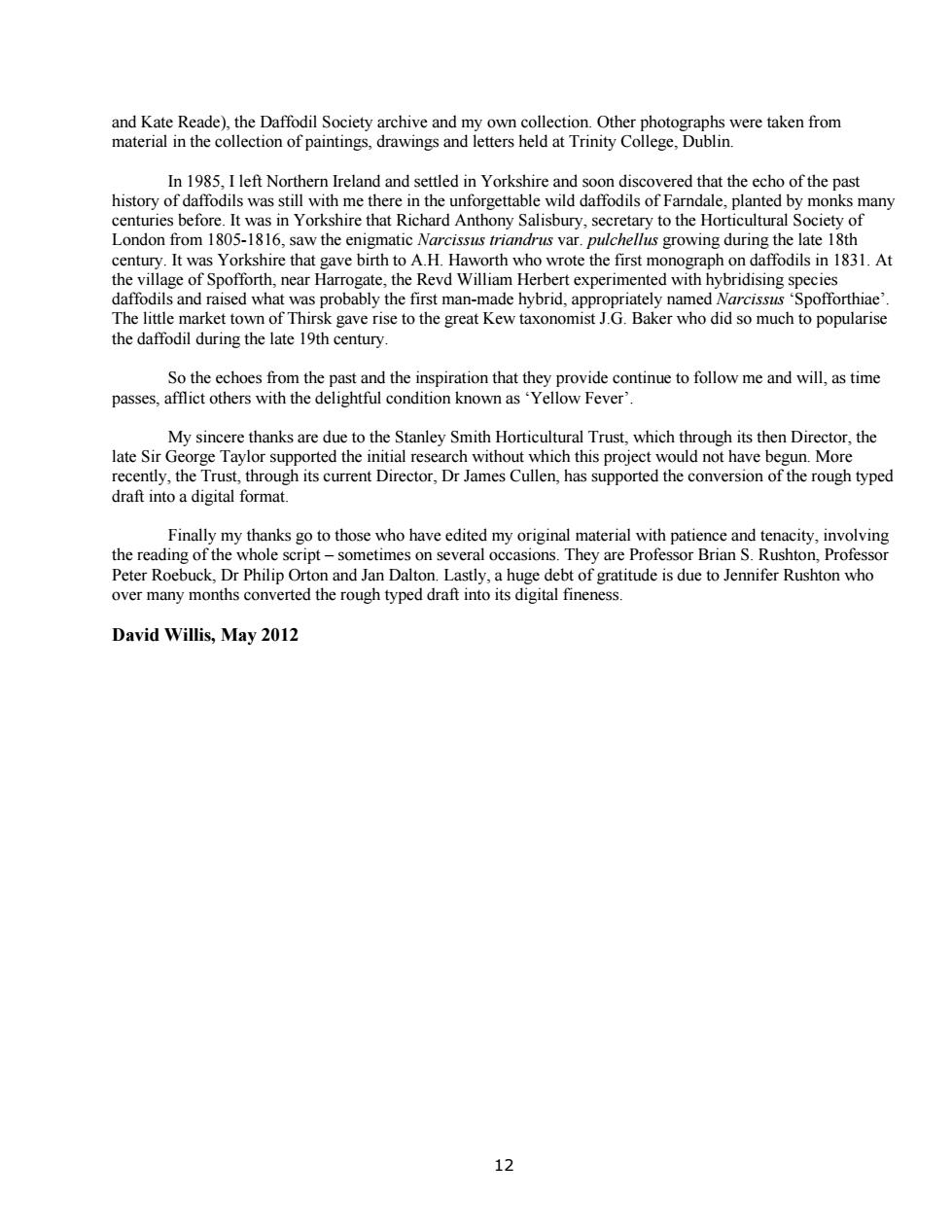正在加载图片...

and Kate Re In 1985,I left Ireland and settled in Yorkshir d that the ec cho of the Yorkhire thatRhyrto the Hr history o ndale London from 1805-1816,saw the enigmatic Narcissus triandrus var.pulchellus growing during the late 18th century.It was Yorkshire that gave birth to A.H.Haworth who wrote the first monograph on daffodils in 1831.At the village of Spofforth,near Harrogate,the Revd William Herbert experimented with hybridising species daffodils and aised what was probably the first man- Spofforthiae Baker who did so much to popularise the dar late 19th century so the echoes from the past and the inspiration that the rovide continue to follow me and will,as time passes,affict others with the delightful condition known asYellow Fever My sincere thanks are due to the Stanley Smith Horticultural Trust,which through its then Director,the recentlytheTrust through itsrr. thanks go to those who have edited my original material with nd te involving -sometimes on several occasions.They are Professor Brian S.Rushton.Professor Peter Roebuck,Dr Philip Orton and Jan Dalton.Lastly,a huge debt of gratitude is due to Jennifer Rushton who over many months converted the rough typed draft into its digital fineness. David Willis,May 2012 1212 and Kate Reade), the Daffodil Society archive and my own collection. Other photographs were taken from material in the collection of paintings, drawings and letters held at Trinity College, Dublin. In 1985, I left Northern Ireland and settled in Yorkshire and soon discovered that the echo of the past history of daffodils was still with me there in the unforgettable wild daffodils of Farndale, planted by monks many centuries before. It was in Yorkshire that Richard Anthony Salisbury, secretary to the Horticultural Society of London from 1805-1816, saw the enigmatic Narcissus triandrus var. pulchellus growing during the late 18th century. It was Yorkshire that gave birth to A.H. Haworth who wrote the first monograph on daffodils in 1831. At the village of Spofforth, near Harrogate, the Revd William Herbert experimented with hybridising species daffodils and raised what was probably the first man-made hybrid, appropriately named Narcissus ‘Spofforthiae’. The little market town of Thirsk gave rise to the great Kew taxonomist J.G. Baker who did so much to popularise the daffodil during the late 19th century. So the echoes from the past and the inspiration that they provide continue to follow me and will, as time passes, afflict others with the delightful condition known as ‘Yellow Fever’. My sincere thanks are due to the Stanley Smith Horticultural Trust, which through its then Director, the late Sir George Taylor supported the initial research without which this project would not have begun. More recently, the Trust, through its current Director, Dr James Cullen, has supported the conversion of the rough typed draft into a digital format. Finally my thanks go to those who have edited my original material with patience and tenacity, involving the reading of the whole script – sometimes on several occasions. They are Professor Brian S. Rushton, Professor Peter Roebuck, Dr Philip Orton and Jan Dalton. Lastly, a huge debt of gratitude is due to Jennifer Rushton who over many months converted the rough typed draft into its digital fineness. David Willis, May 2012